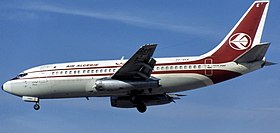Air Algérie flight 702P
| Air Algèrie flight 702P | |
|---|---|
|
The 7T-VEE aircraft that crashed |
|
| Accident summary | |
| Accident type | Controlled flight into terrain |
| place | at Coventry Airport , United Kingdom |
| date | December 21, 1994 |
| Fatalities | 5 |
| Survivors | 0 |
| Aircraft | |
| Aircraft type |
|
| operator |
|
| Mark |
|
| Surname | Oasis |
| Departure airport |
Amsterdam Schiphol Airport , Netherlands |
| Stopover |
East Midlands Airport , UK (unscheduled)
|
| Destination airport |
Coventry Airport , UK |
| Passengers | 0 |
| crew | 5 |
| Lists of aviation accidents | |
On December 21, 1994, a Boeing 737-26DC with the aircraft registration 7T-VEE of Air Algérie , which was operated for Phoenix Aviation , had an accident on Air Algèrie flight 702P . The five crew members on board the machine were killed in the accident.
plane
The affected machine was a Boeing 737-26DC, which was finally assembled at the Boeing plant in Renton , Washington, and which made its maiden flight on May 17, 1973. The aircraft had the factory number 20758, it was the 322nd Boeing 737 from ongoing production. The machine was delivered brand new to Air Algérie on May 25, 1973, which has operated it continuously since then. The twin- engined narrow -body aircraft was equipped with two Pratt & Whitney JT8D-15 engines. By the time of the accident, the machine had completed a total of 45,633 operating hours.
crew
On board the machine was a five-person crew, including a two-person cockpit crew, consisting of a flight captain and a first officer, both of whom were provided by the Air Algèrie.
The 44-year-old flight captain was an Algerian citizen and had type ratings for the aircraft types Boeing 727 , Boeing 737 , Airbus A300 , Airbus A310 and Fokker F-27 . The captain of the machine had 10,686 hours of flight experience, 2,187 of which he had completed in the cockpit of the Boeing 737.
The 35-year-old first officer was also an Algerian citizen and had type ratings for the Boeing 737, Fokker F-27 and Cessna 310 aircraft . The first officer had 2,858 hours of flight experience, of which he had completed 2,055 hours in the cockpit of the Boeing 737.
Course of the flight and course of the accident
On the day of the accident, the plane departed from Amsterdam Schiphol Airport on a flight that was supposed to lead directly to Coventry Airport . Live animals intended for export to the Netherlands and France were to be loaded in Coventry . Weather conditions in Coventry were difficult and worsened during the day, as the plane approached the airport, visibility was reduced to 700 meters. The pilots received clearance to land on runway 23. Since the aircraft's navigation receiver did not meet the latest standard, no ILS approach could be carried out. For this reason, the pilots opted for an approach actively supported by air traffic control with the help of the approach surveillance radar. This failed, whereupon the captain made a missed approach and took the plane to East Midlands Airport , where the Boeing could be safely landed.
About 90 minutes after landing at East Midlands Airport, visibility in Coventry improved significantly. The pilots took off again at 9:38 a.m. to make another attempt to land at the destination airport. During this approach, the pilots flew the Boeing under the glide path until it touched a 26-meter high voltage pylon at a distance of 1.8 kilometers from the runway . In the collision, the left engine and the structure of the left wing were severely damaged. The machine rolled to the left and fell to the ground, brushed against a house and finally fell into a wooded area, where it exploded and caught fire. All five inmates were killed.
root cause
The Aircraft Accident Investigation Branch investigated the accident. It came to the conclusion that the accident occurred after the pilots lowered the machine well below the glide path even though they were unable to establish visual contact with the runway. The pilots had also failed to double-check the altitude readings during the approach, just as the non-piloting pilot had failed to call the safety altitude when the aircraft reached it. It was also found that the crew's performance was impaired due to fatigue.
swell
- Accident report B-737-26DC, 7T-VEE in the Aviation Safety Network
- Operating history B-737-26DC, 7T-VEE on planespotters.net
- Report on the accident to Boeing 737-2D6C, 7T-VEE at Willenhall, Coventry, Warwickshire on December 21, 1994 , Air Accidents Investigation Branch , December 7, 1995.
Coordinates: 52 ° 23 ′ 4 " N , 1 ° 27 ′ 10" W.
